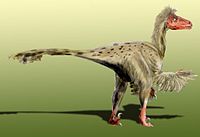Prince Creek Formation
Appearance
| Prince Creek Formation | |
|---|---|
| Stratigraphic range: Maastrichtian, | |
| Type | Geological formation |
| Location | |
| Region | North America |
| Country | |
The Prince Creek Formation is a geological formation in Alaska with strata from the early Maastrichtian stage of the Upper Cretaceous, dating to between 70 and 69 million years ago.[1] Dinosaur remains are among the fossils that have been recovered from the formation.[2]
Vertebrate paleofauna
Theropods
Indeterminate tyrannosaurid remains present, mostly in the form of teeth. [3]
| Theropods of the Prince Creek Formation | ||||||
|---|---|---|---|---|---|---|
| Genus | Species | Location | Stratigraphic position | Abundance | Notes | Images |
|
D. albertensis[4] |
 | |||||
|
N. hoglundi |
||||||
|
S. langstoni[4] |
||||||
|
T. formosus[4] |
||||||
Ornithischians
Color key
|
Notes Uncertain or tentative taxa are in small text; |
| Ornithischians of the Prince Creek Formation | ||||||
|---|---|---|---|---|---|---|
| Genus | Species | Location | Stratigraphic position | Abundance | Notes | Images |
|
A. gangloffi[5] |
||||||
|
Indeterminate[6] |
||||||
|
Indeterminate[7] |
||||||
|
Indeterminate[8] |
||||||
|
P. perotorum[1] |
||||||
|
Indeterminate[8] |
||||||
|
Indeterminate[9] |
Teeth previously attributed to Thescelosaurus are more likely referable to Parksosaurus or a new genus.[8] | |||||
See also
Footnotes
- ^ a b c Fiorillo, A.R. and Tykoski, R.S.T., 2012. "A new species of the centrosaurine ceratopsid Pachyrhinosaurus from the North Slope (Prince Creek Formation: Maastrichtian) of Alaska." Acta Palaeontologica Polonica, available online 26 Aug 2011. doi:10.4202/app.2011.0033
- ^ Weishampel, David B; et al. (2004). "Dinosaur distribution (Late Cretaceous, North America)." In: Weishampel, David B.; Dodson, Peter; and Osmólska, Halszka (eds.): The Dinosauria, 2nd, Berkeley: University of California Press. Pp. 574-588. ISBN 0-520-24209-2.
- ^ Journal of Vertebrate Paleontology 20(4):675–682, December 2000: THEROPOD TEETH FROM THE PRINCE CREEK FORMATION (CRETACEOUS) OF NORTHERNALASKA, WITH SPECULATIONS ON ARCTIC DINOSAUR PALEOECOLOGY ANTHONY R. FIORILLO and ROLAND A. GANGLOFF
- ^ a b c d e f "3.33 Alaska, United States; 3. Prince Creek Formation," in Weishampel, et al. (2004). Page 587.
- ^ a b Sullivan, R.M., 2006. A taxonomic review of the Pachycephalosauridae (Dinosauria: Ornithischia). New Mexico Museum of Natural History and Science Bulletin 35: 347-365.
- ^ a b Listed as "?Anchiceratops sp." in "3.33 Alaska, United States; 3. Prince Creek Formation," in Weishampel, et al. (2004). Page 587.
- ^ a b Listed as "?Brachyceratops sp." in "3.33 Alaska, United States; 3. Prince Creek Formation," in Weishampel, et al. (2004). Page 587.
- ^ a b c d e Brown, C.M. and Druckenmiller, P. (2011). "Basal ornithopod (Dinosauria: Ornithischia) teeth from the Prince Creek Formation (early Maastrichtian) of Alaska." Canadian Journal of Earth Sciences (advance online publication) doi:10.1139/e11-017
- ^ a b Listed as "cf. Thescelosaurus sp." in "3.33 Alaska, United States; 3. Prince Creek Formation," in Weishampel, et al. (2004). Page 587.
References
- Weishampel, David B.; Dodson, Peter; and Osmólska, Halszka (eds.): The Dinosauria, 2nd, Berkeley: University of California Press. 861 pp. ISBN 0-520-24209-2.
